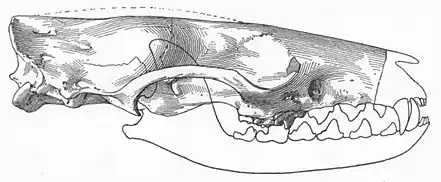Viverravus
Viverravus ("ancestor of Viverra") is an extinct genus of placental mammals from extinct subfamily Viverravinae within extinct family Viverravidae, that lived in North America, Europe and Asia from the middle Paleocene to middle Eocene.[6][7][8]
| Viverravus | |
|---|---|
 | |
| skull of Viverravus minutus | |
| Scientific classification | |
| Domain: | Eukaryota |
| Kingdom: | Animalia |
| Phylum: | Chordata |
| Class: | Mammalia |
| Superfamily: | †Viverravoidea |
| Family: | †Viverravidae |
| Subfamily: | †Viverravinae |
| Genus: | †Viverravus Marsh, 1872[2] |
| Type species | |
| †Viverravus gracilis Marsh, 1872 | |
| Species | |
|
[see classification] | |
| Synonyms | |
|
synonyms of genus:
synonyms of species:
| |
Classification and phylogeny
Taxonomy
| Species: | Distribution of the species and type locality: | Age: |
|---|---|---|
| †V. acutus (Matthew & Granger, 1915)[9] | 56.2 - 50.5 Ma | |
| †V. gracilis (Marsh, 1872)[2] |
|
54.9 - 46.2 Ma |
| †V. lawsoni (Hooker, 2010)[10] | 56.0 - 55.2 Ma | |
| †V. laytoni (Gingerich & Winkler, 1985)[11] | 60.9 - 54.9 Ma | |
| †V. lutosus (Gazin, 1952)[12] |
|
54.9 - 46.2 Ma |
| †V. minutus (Wortman, 1901)[13] | 54.9 - 39.7 Ma | |
| †V. politus (Matthew & Granger, 1915) | 60.9 - 50.5 Ma | |
| †V. rosei (Polly, 1997)[14] | 56.2 - 50.5 Ma | |
| †V. sicarius (Matthew, 1909)[15] |
|
50.5 - 39.7 Ma |
| †V. sp. [V11141] (Meng, 1998)[16] | 42.0 - 39.9 Ma | |
| †V. sp. [Locality Group 2, Washakie Basin, Wyoming] (Tomiya, 2021)[17] | 47.0 - 46.2 Ma |
Phylogeny
The phylogenetic relationships of genus Viverravus are shown in the following cladogram:[18][11][14][19]
| Carnivoramorpha |
| |||||||||||||||||||||||||||||||||||||||||||||||||||||||||||||||||||||||||||||||||||||||||||||||||||||||||||||||||||||
See also
References
- "Viverravus". www.mindat.org. Retrieved 2021-07-08.
- O. C. Marsh (1872.) "Preliminary description of new Tertiary mammals. Part I." American Journal of Science 4(20):122-128
- O. C. Marsh (1871.) "Notice of some new fossil mammals and birds from the Tertiary formation of the West." American Journal of Science 2(8):120-127
- E. D. Cope (1881.) "On the Vertebrata of the Wind River Eocene beds of Wyoming." Bulletin of the United States Geological and Geographical Survey 6(1):183-202
- P. D. Gingerich. (1987.) "Early Eocene bats (Mammalia, Chiroptera) and other vertebrates in freshwater limestones of the Willlwood Formation, Clark's Fork Basin, Wyoming." Contributions from the Museum of Paleontology, University of Michigan 27(11):275-320
- McKenna, Malcolm C.; Bell, Susan K. (1997). Classification of Mammals Above the Species Level. New York: Columbia University Press. ISBN 978-0-231-11012-9. Retrieved 16 March 2015.
- J. J. Flynn (1998.) "Early Cenozoic Carnivora ("Miacoidea")." In C. M. Janis, K. M. Scott, and L. L. Jacobs (eds.) "Evolution of Tertiary Mammals of North America. Volume 1: Terrestrial Carnivores, Ungulates, and Ungulatelike Mammals." Cambridge University Press, Cambridge. ISBN 0-521-35519-2
- Viverravus in Fossil Works / Paleodb.org
- W. D. Matthew and W. Granger (1915.) "A revision of the Lower Eocene Wasatch and Wind River faunas." Bulletin of the American Museum of Natural History 34(1):1-103
- Jerry J. Hooker (2010). ""The mammal fauna of the early Eocene Blackheath Formation of Abbey Wood, London"". Monographs of the Palaeontographical Society. Palaeontographical Society. 164 (634): 1–162. doi:10.1080/25761900.2022.12131814. ISSN 0269-3445. S2CID 250702284.
- P. D. Gingerich and D. A. Winkler (1985.) "Systematics of Paleocene Viverravidae (Mammalia, Carnivora) in the Bighorn Basin and Clark's Fork Basin, Wyoming." Contributions from the Museum of Paleontology, University of Michigan 27(4):87-128
- C. L. Gazin (1952.) "The Lower Eocene Knight Formation Of Western Wyoming and Its Mammalian Faunas." Smithsonian Miscellaneous Collections 117(18):1-82
- J. L. Wortman (1901.) "Studies of Eocene Mammalia in the Marsh Collection, Peabody Museum." The American Journal of Science, series 4 12:193-206
- P. D. Polly (1997.) "Ancestry and Species Definition in Paleontology: A Stratocladistic Analysis of Paleocene-Eocene Viverravidae (Mammalia, Carnivora) from Wyoming." Contributions from the Museum of Paleontology, University of Michigan 30(1):1-53
- W. D. Matthew (1909.) "The Carnivora and Insectivora of the Bridger Basin, middle Eocene." Memoirs of the American Museum of Natural History 9:289-567
- J. Meng, R. J. Zhai and A. R. Wyss (1998.) "The late Paleocene Bayan Ulan fauna of Inner Mongolia, China." Bulletin of Carnegie Museum of Natural History 34:148-185
- Tomiya, S.; Zack, S. P.; Spaulding, M.; Flynn, J. J. (2021). "Carnivorous mammals from the middle Eocene Washakie Formation, Wyoming, USA, and their diversity trajectory in a post-warming world". Journal of Paleontology. 95 (Supplement S82): 1–115. doi:10.1017/jpa.2020.74. S2CID 232358160.
- Flynn, John J.; Galiano, Henry (1982). "Phylogeny of Early Tertiary Carnivora, With a Description of a New Species of Protictis From the Middle Eocene of Northwestern Wyoming". American Museum Novitates (2725): 1–64. hdl:2246/5338.
- S. Faurby, L. Werdelin, A. Antonelli (2019.) "Dispersal ability predicts evolutionary success among mammalian carnivores" Department of Biological and Environmental Sciences, University of Gothenburg, Box 461, SE